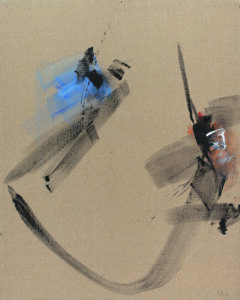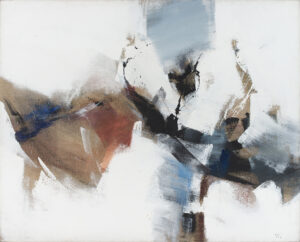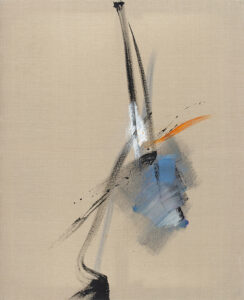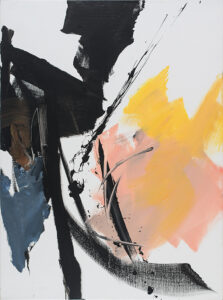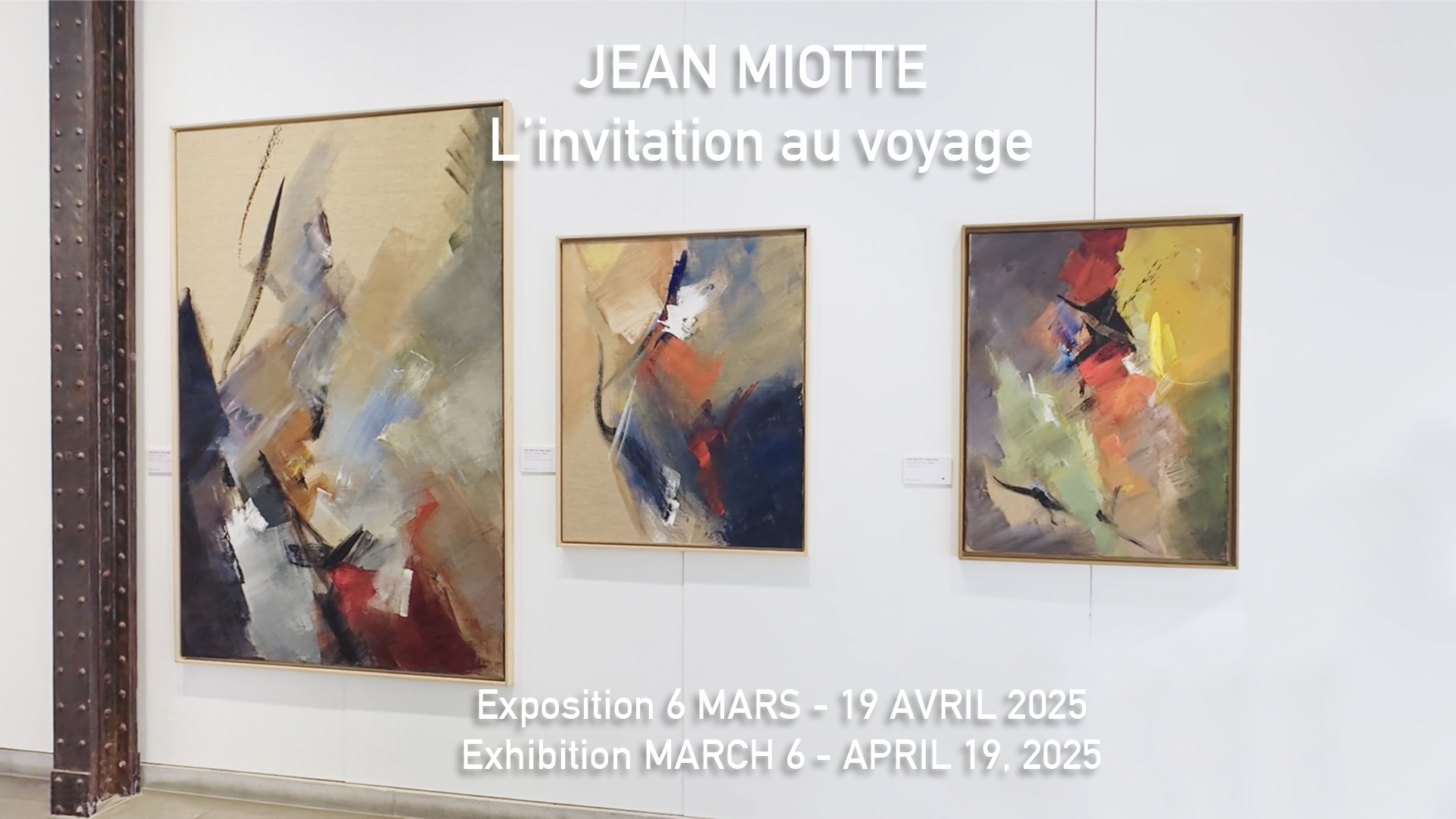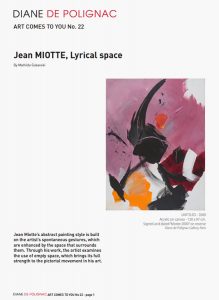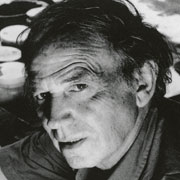
(1926-2016)
The Gallery represents the Estate of the artist Jean Miotte and has been working in partnership with the Jean Miotte Foundation since 2022.
Jean Miotte was a French painter. His personal form of abstraction places him at the limit between Informal Art, Tachisme and Lyrical Abstraction. The painter Jean Miotte was especially interested in the representation of movement in his art.
Exhibitions
Publications
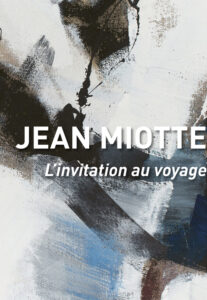
JEAN MIOTTE
L’invitation au voyage
Catalog 86 pages – Text by Camille Laura Villet

JEAN MIOTTE & LA DANSE
Une abstraction chorégraphique
Catalog 80 pages – Texts by Amandine Albisson & Astrid de Monteverde

JEAN MIOTTE
Un geste qu’on porte en soi
Harmonie, impulsion, équilibre
Catalog 64 pages – Text by Lydia Harambourg
Videos
Presentation of the exhibition “JEAN MIOTTE”.
Artwork analysis
The Years of Studies of the Painter Jean Miotte
Jean Miotte was born in Paris on September 8th, 1926 and spent his youth in Occupied Paris: he was eighteen years old at the end of the war. “It was in this context of upheaval and planetary ideological turmoil that his desire for other values, other spiritual commitments was exacerbated. His hostility towards all forms of regimentation, group effects, dates from this time. At the age of nineteen, he had decided, his path would be solitary” wrote Serge Lenczner.
After studying mathematics, Jean Miotte completed his military service. The artist explained: “I was struck by the ugliness of the facilities and the wall decorations in the surrounding area, and I swore to myself from the moment I saw them that I would transform them.” As such, he began painting the walls in the break rooms – “With Pop Art before its time” noted Miotte, and “Beautiful girls on beaches to entertain the soldiers…” – as well as sets for the barracks theatre. Stricken with tuberculosis, Miotte’s military service was cut short and he was hospitalised for several months, during which time he practised painting and drawing. Once he had recovered, he continued his artistic endeavours in Paris – which was brimming with activity – and attended a number of free art schools in Montparnasse, such as the Académie de la Grande Chaumière and the studios of Othon Friesz and Ossip Zadkine, among others. At this time, Miotte painted nude models as well as imaginary compositions. He was very interested in Jacques Villon, Georges Rouault and Henri Matisse.
The Importance of Dance to Jean Miotte’s Art
In 1948, Miotte followed his Russian friends to London where the Ballets Russes de Colonel W. de Basil were performing. It was with great joy that he discovered the world of dance. The artist explained: “I savoured the first wonders and discoveries of the choreographic world, the arabesques, the theatrical organisation of lines, of rhythm…” Miotte became friends with some of the key figures in dance, including the dancers Zizi Jeanmaire, Wladimir Skouratoff and Rosella Hightower, who even asked him to design sets for her choreographic works. Miotte thus became involved with the Grand Ballet du Marquis de Cuevas – whose members included Rosella Hightower and Wladimir Skouratoff – which was based in Monte Carlo. Towards the end of the 1940s, Miotte often depicted dancers in his work. After that, Miotte’s painting became non-figurative, drawing on dramatic play and performance. Movement became fundamental to his work. Jean-Clarence Lambert described his work as a form of “choreographic abstraction”. Miotte wanted to achieve a fusion of the visual and performing arts. “I have a passion for dance and choreography…” he confided, “I dream of a magnificent synthesis of painting, music and choreography.” Throughout his career, Jean Miotte created a number of stage sets and costumes. In 1994, his spectacular five-metre canvas Sud (South) entered the collection of the Opéra Bastille, where it is on display today.
Jean Miotte’s Early Successes
Jean Miotte travelled to Italy and discovered Quattrocento art. He also met the artists Piero Dorazio, Lorenzo Guerrini and Achille Perilli. On returning to Paris, Jean Miotte was influenced by the paintings of Robert Delaunay and Fernand Léger.
Miotte painted his first abstract painting in 1950. He was living and working in Meudon, where he made friends with the artists Jean Arp and Gino Severini – two key figures, one in the world of abstract art, the other in terms of the importance of movement. Jean Miotte also developed a close relationship with Sam Francis, whom he met in 1952 and visited in his studio in Ville-d’Avray. In 1953, Jean Cassou bought a painting by Jean Miotte for the Musée d’Art Moderne in Paris. In the same year, Miotte had his first exhibition at the Salon des Réalités Nouvelles, an event in which he would participate regularly from then on. The same year, the art critic Michel Seuphor contacted him for his publication Dictionnaire de l’art abstrait which was published in 1957. Miotte’s painting is described in it as: “highly coloured compositions with clearly articulated design that have wall power.” Jean Miotte is a personal work, between Lyrical Abstraction, Informal Art and Tachisme. “The names of the artists who, with their lyricism, are an exception to the general rule of coldness… Jean Miotte, by whom bright and airy painting transmits an undeniable emotion,” wrote the art critic Alain Jouffroy. Jean Miotte’s paintings were created with an immediate gesture, a dazzling energy. “Movement is my life” he recalled. In this, he can be compared to Jackson Pollock.
Jean Miotte never prepared his work with sketches. This differentiated him from Hans Hartung for example. The American art critic Harold Rosenberg appreciated this practice especially: “the most important thing in art is freshness”.
This free and instinctive form of painting was also influenced by Surrealism. The spirit was liberated of all constraints of reflection: “it is the intuition that counts above all when a work is born”. Jean Miotte evoked his work as the “result of internal conflicts, my painting is a projection; a succession of acute moments where creation happens in full spiritual tension. Painting is not a speculation of the mind or the intellect, it is a gesture that is carried within.” Jean Miotte met Roberto Roberto Matta who told him: “Surrealism is for me a battle. (…) You, too, you’re a fighter, you’re like me, your paintings aren’t abstract.”
The influence of Cubism is also present. Just as his predecessors decomposed to recompose, Miotte “unmakes”. According to Karl Ruhrberg, with Jean Miotte, it is “the orchestration of a world that explodes”. He also underlined Jean Miotte’s strong connection to his northern origins, especially Frans Hals, “who, like him allied spontaneous painting and harmony between impulse and balance.”
In 1954, Jean Miotte moved his studio to the townhouse of the sculptor Prince Youriévitch in Boulogne, where the artists Jacques Lanzman and Serge Rezvani were also living. The following year, the painter Henri Goetz brought his pupils to visit this studio.
In 1957, Jean Miotte participated in the exhibition 50 Ans d’Art Abstrait at the Galerie Creuse in Paris. A solo exhibition of his work was held at the Galerie Lucien Durand in the same city. From 1958, Jean Miotte was represented in Europe by the dealer Jacques Dubourg. That year, Jean Miotte met the painters André Lanskoy, Serge Poliakoff and Pierre Dmitrienko.
In 1957, Jean Miotte participated in the exhibition 50 Ans d’Art Abstrait at the Galerie Creuse in Paris. A solo exhibition of his work was held at the Galerie Lucien Durand in the same city. From 1958, Jean Miotte was represented in Europe by the dealer Jacques Dubourg. That year, Jean Miotte met the painters André Lanskoy, Serge Poliakoff and Pierre Dmitrienko.
Jean Miotte became successful in Germany where ten exhibitions were devoted to his work during the 1950s, for example at the Kunsthalle of Recklinghausen in 1958. He was also included in a group exhibition of fifteen painters at the Cologne Kunstverein. In 1960, the Ludwig Museum of Cologne acquired a work by Jean Miotte.
The painter Jean Miotte’s First trip to the USA
Jean Miotte exhibited at the first Paris Biennale in 1959 in the “Section Informels” with Raymond Hains, LeRoy Neiman, Peter Foldes and André Favory. The following year, two paintings by Jean Miotte were included in the inaugural exhibition of the Galerie Karl Flinker in Paris. Paintings by him were also included in the inaugural exhibition of the Galerie Iris Clert. In 1961, Jean Miotte participated with Sam Francis, Georges Mathieu and Jean-Paul Riopelle in the group exhibitions of the Swenska-Franska Gallery in Stockholm and the Galerie Bonnier in Lausanne. That year, he was awarded the Ford Foundation Prize and was invited to spend six months in the USA. The following year, a solo show of his work was organized by the Iolas Gallery in New York. Jean Miotte met the American artists Robert Motherwell, Mark Rothko, Chaïm Jacob Lipchitz and Alexander Calder. He travelled around the USA and gave a lecture at Colorado Spring University.
International Recognition for the Painter Jean Miotte
In 1963, a Jean Miotte retrospective was organized by the Stedelijk Museum of Schiedam and it then transferred to the Groningen Museum in the Netherlands. Jean Miotte participated the same year in the group exhibition Art Contemporain at the Grand Palais in Paris. In February 1964, the Portuguese art historian José-Augusto França wrote about Jean Miotte’s painting in the magazine Costruire: “A gestural painter in the French spirit, Miotte expresses himself in the constructive despite the impression of immediate vehemence that emanates from his paintings:his art goes beyond the post-war aesthetic, standing out in a more modern way by a conscience of the independence of the idea of creating.” During the 1960s, many exhibitions of Jean Miotte’s work were organized in Germany, the Netherlands, Denmark and in Belgium. At that time, he worked in the south of France, at Pignans.
In 1967, he was again included in an exhibition at the Schiedam Stedelijk Museum, the group show Huit peintres de Paris, along with Chafik Abboud, Olivier Debré, Karskaya, Jean Messagier, Carl Moser, Louis Nalard and Paul Rebeyrolle.
In 1970, Jean Miotte became a member of the Comité des Réalités Nouvelles. He exhibited forty paintings at the Fondation Prouvost at Marcq-en-Baroeul. In 1971, Jean Miotte started using hessian bare canvas as an element in his compositions. The following year, he again spent time in the USA, this time in New York and Washington. Forty-six of his canvases were exhibited at the International Monetary Fund in Washington. Jean Miotte moved his studio to Hamburg in Germany.
In 1975, a monograph on Jean Miotte was published, containing a text by the dealer Castor Seibel: “no imitation, no reproduction, but the internal event finds its expression in the colours and a gestural dynamic… Miotte’s painting is a place where the contradictions of our age are no longer expressed in a dualist way… In this sense, J.M. is an important creator of new forms.”
The following year, Jean Miotte experimented with paper as a support and made eighty gouaches as well as collages of brown paper and newspaper. One of his works was acquired by the Museum of Maassluis in the Netherlands. He exhibited in Padua alongside Enrico Baj, Alexander Calder and Karel Appel. Jean Miotte moved his studio to Vitry-sur-Seine. He exhibited at the Malines cultural centre in Belgium at the group show Kunst in Europa 1920-1960 which brought together the big names in contemporary art of the time.
JEAN MIOTTE ’S TRAVELS IN ASIA
In May 1980, Jean Miotte exhibited fifty works in Beijing at the French cultural centre. He was the first western painter to be invited to exhibit his work in Beijing after Mao’s death. Jean Miotte took this opportunity to travel around China. In 1982, he exhibited sixty paintings at the Hong Kong Art Center and then at the French-Japanese Institute of Tokyo. The following year, Jean Miotte exhibited at the Singapore National Museum and at the National Museum of History of Taipei. In 1984, he was exhibited at the Striped House Museum of Tokyo.
The Guggenheim Museum acquired two works on paper by Jean Miotte in 1987. In 1991, the Centre Georges Pompidou in Paris exhibited the prints commissioned by Danielle Mitterrand for her album Mémoire de la liberté. Fifty-five artists were involved in this project including Jean Miotte, Roy Lichtenstein, Antoni Tapies, Sam Francis and Robert Rauschenberg. The following year, a Jean Miotte retrospective was organized at the Palais des Arts de Toulouse.
The Jean Miotte Foundation was opened in New York in 2002 with a permanent collection of his works. It is nowadays based in Fribourg (Switzerland). Jean Miotte died on March 1st, 2016 at the age of 89.
© Diane de Polignac Gallery / Mathilde Gubanski
Translation: Jane Mac Avock

Selected collections
Selected collections
Berlin, Graphotek
Castellon, Museo de Arte Contemporáneo de Villafamés
Cologne, Museum Ludwig
Dortmund, Museum am Ostwall
Dhaka, Bangladesh National Museum
Dunkirk (France), Musée d’Art Contemporain
Hamburg, Staats-und Universitätsbibliothek Hamburg Carl von Ossietzky
Maassluis (the Netherlands), Gemeentemuseum
Munich, Staatsgalerie Moderner Kunst
New York, The Solomon R. Guggenheim Museum
New York, The Museum of Modern Art
New York, The Chelsea Art Museum
Paris, Musée d’Art Moderne de la Ville de Paris
Paris, Bibliothèque Nationale
Paris, Ministère des Affaires Culturelles
Paris, Opéra National Bastille
Paris – La Défense, Fonds National d’Art Contemporain (FNAC)
Paris – La Défense, Fondation d’Art Contemporain CNIT
Rio de Janeiro, Museo de Arte Moderna
Saarbrucken (Germany), Saarlandmuseum, Moderne Galerie
Singapore, National Museum of Singapore
Taichung, Museum of Fine Arts Taiwan
Selected exhibitions
Selected exhibitions
Salon des Réalités Nouvelles, Paris, 1953. Participated regularly from this date on
Exposition d’Ouverture, Galerie du Haut du Pavé, Paris, 1954
50 Ans d’Art Abstrait, to coincide with the publication of the Dictionnaire de la Peinture abstraite by Michel Seuphor, Galerie Creuse, Paris, 1957
Galerie Lucien Durand, Paris, 1957
Réalités Nouvelles, Nouvelles Réalités, 13e Salon des Réalités Nouvelles, Kunsthalle de Recklinghausen, Recklinghausen (Germany), 1958
Cinq Peintres de Paris: Bogart, Bysantios, Jousselin, Miotte, Mihailovitch, Galleria Attico, Rome, 1958
Section Informel: Hains, Miotte, Neiman, Foldes, Favory …, First Paris Biennale, Paris, 1959
15 Peintres de Paris, Kolnischer Kunstverein, Cologne, 1959, 1962
Ouverture, Galerie Flinker, Paris, 1960
Ouverture, Galerie Iris Clert, Paris, 1960
Galerie Am Dom, Frankfurt, 1960
Galerie Gunar, Düsseldorf, 1960
Exposition Internationale, Museum Wolfram Von Eschenbach, Wolframs-Eschenbach (Germany), 1961
Sam Francis, Mathieu, Miotte, Riopelle, Galerie Swenska Franska, Stockholm, 1961
Galerie Bonnier, Lausanne, 1961
Drian Gallery, London, 1961
Centre Culturel de Mechelen, Mechelen (Belgium), 1961, 1976
Galerie Iolas, New York, 1962
Galerie Jacques Dubourg, Paris, 1963
Stedelijk Museum, Schiedam (The Netherlands), 1963, 1967
Groninger Museum, Groningen (The Netherlands), 1963
Galerie Zodiaque, Brussels, 1963
Grand Palais, Paris, 1963, 1988
Cobra et l’Informel: Appel, Constant, Corneille, Miotte, Riopelle, Tal Coat, Galerie Krikhaar, Amsterdam, 1965
Galerie Dierks, Aarhus (Denmark), 1966, 1968, 1971
Court Gallery, Copenhagen, 1966
Galerie Bio, Aalborg (Denmark), 1967
International Graphies, The Corcoran Gallery of Art, Washington DC, 1970
Galerie Wünsche, Bonn, 1970, 1974, 1976
Septentrion, Centre Artistique de la Fondation A. Prouvost, Marcq-en-
Baroeul (France), 1970
Huit Peintres de Paris: Abboud, Debré, Karskaya, Messagier, Moser, Miotte, Nalard, Rebeyrolle, Maison de la Culture, Bourges, 1971
International Monetary Fund, Washington DC, 1972
Galerie Dinastia, Lisbon, 1972
Prudhoe Gallery, London, 1973, 1974
Galerie Winter, Braunschweig (Germany), 1975, 1978
Galerie Nieuwe Weg, Doorn (The Netherlands), 1976, 1979, 1984, 1991
Cinq Artistes : Appel, Baj, Calder, Miotte, Scordia, Galerie Alfiere, Padua, 1976
Bishops Gallery, Melbourne, 1977
Damascus Cultural Center, Damascus, 1978
National Museum, Alep, 1978
Amman Cultural Center, Amman, 1978
Musée de Dunkerque, Dunkirk, 1978, 1993
L’Abstraction des Années 50 en France, Maison de la Culture, Grenoble, 1978
L’Abstraction des années 50 en France, Musée de Saint-Omer, 1978
Travelling retrospective in French cultural centres, 1979
Beijing Cultural Center, Beijing: First exhibition of a western artist in the People’s Republic of China, 1980
Galería Lucas, Gandía (Spain), 1980, 1981
Galerie Koppelmann, Leverkusen (Germany), 1980, 1983
Centre Culturel, Montpellier, 1980
Ayala Museum, Manilla, 1981
Museum für Kommunikation Hamburg, Hamburg, 1981
Evergreen Galleries, The Evergreen State College, Olympia, Washington D.C, 1982
Hong-Kong Arts Center, Hong-Kong, 1982
Institut Franco-Japonais de Tokyo, Tokyo, 1982
Trevisan Galleries, Edmonton (Canada), 1982
Paris 59: Fautrier, Feraud, Hartung, Lanskoy, Lipsi, Miotte, Schneider, Sonderborg, Soulages, TaI Coat, Tapies, Galerie Koppelmann, Cologne, 1982
Singapore, National Museum of Singapore, 1983
National Museum of History, Taipei, 1983
Bitran, Chu teh-Chun, Hartung, Miotte, Soulages, Chapelle des Franciscains, Saint-Nazaire, 1983
Galerie La Cité, Luxemburg, 1983, 1987
Striped House Museum, Tokyo, 1984
Vik Gallery, Edmonton (Canada), 1984
Institut Français d’Athènes, Athens, 1984
Deux Peintres, Deux Sculpteurs, Orangerie de Bagatelle, Paris, 1984
Opus Gallery, Miami, 1985
Konstmassan, Stockholm, 1985, 1989
Art Atrium, Stockholm, 1985
Columbia University, New York, 1986
Galerie Keeser, Hamburg, 1987, 1989, 1991
Les Peintres autour d’Arrabal, Musée d’Histoire, Esch-sur-Alzette, Luxemburg, 1987
Ciae, Chicago International Art Exhibition, Chicago, 1987
Colloque Euro-Arabe, National Museum of Malta, Malta, 1987
Art in Paris, Pavillon Inter-Continental, Singapore, 1987
Galerie Gimpel & Weitzenhoffer, New York, 1988
Galerie Egelund, Holte, Denmark, 1988, 1990
Espace d’Art Contemporain E. Ungaro, La Rochelle, 1988
Rencontres Écrites, Institut du Monde Arabe, Paris, 1988
Les Années 50: Benrath, Chu teh-Chun, Debré, Dietrich Mohr, Féraud, Hartung, Lanskoy, Miotte, Music, Père, Pichette, de Staël, Subira Puig, Casino de Hyeres, Hyères, 1988
Les années 50, Mécénat Pernod, Paris-Créteil, First venue of a travelling, 1988
Galerie N’namdi, Detroit, 1989
Miotte/Arrabal, Maler und Dichter, Institut Français de Hambourg, Hamburg, 1989
Galerie von Braunbehrens, Munich, 1990, 1992, 1996
Galerie Wild, Frankfurt, 1990, 1992, 1994, 1997
Abstrakte Malerei nach 1945: Miotte, Noël, Schumacher, Sonderborg, Thieler, Haus Sandreuther, Riehen-Basel, 1990
Art et Partage, Musée des Beaux-Arts, Nice, 1990
Seibu Museum, Tokyo, 1991
Galerie Jade, Colmar,1991, 1992
Galerie Michael Schultz, Berlin, 1991, 1993, 1997
Mémoire de la Liberté: 55 artists from 23 countries, César, Sam Francis, Miotte, Rauschenberg, Motherwell, Lichtenstein, Tinguely, Tapies, etc., illustrate each article of the Universal Declaration of Human Rights, organized by the Association France Liberté, Centre Pompidou, Paris, 1991
Collections des Collections; de Paul Klee à Nos Jours, CNIT, Fondation d’Art Contemporain, Paris-La Défense, 1991
Couleurs de la Vie, international travelling exhibition of contemporary art under the patronage of Mme Danielle Mitterand, Bibliothèque Nationale, Paris, 1991
Forms of Abstraction, N’namdi Gallery, Birmingham, Michigan, 1991
Palais des Arts, Toulouse, 1992
Shuyu Gallery, Tokyo, 1992
Galerie Saint-Polly, Gunrua (Japan), 1992
Art and Art, Nicaf 92, Yokohama, 1992
Grands Formats, Miami Art Fair, Miami, 1992
Art Multiple, Düsseldorf, 1992, 1994
5 Artistes des Années 50: Christophorou, Debré, Miotte, Féraud, Koch, Centre Culturel Jean Despas, Saint-Tropez, 1993
Hartung et Miotte, Ishi Gallery, Osaka, 1993
Musée des Cordeliers, Châteauroux, 1994
Graphic works, Musée Bertrand, Châteauroux, 1994
30 ans Après: Sam Francis, Jean Miotte, Joan Mitchell, Jean-Paul Riopelle, organized by Chapel Art Center, Hamburg and Cologne, 1994, 1995, 1997
Pour la Paix et la Reconstruction au Liban – 33 Peintres, Musée Sursock, Beirut, 1994
Chinesische Kunst nach 1945 in Europa – Eine Gegenüberstellung : Li Di, Chu teh-Chun, Zao
Rétrospective 1956-1996, Musée Mücsarnok, Budapest, 1996
Les Années 1945-1975, Maison de l’Unesco, Paris, 1996
Arrabal, der Lyriker und die Künstler, Dali, Dorny, Miotte, Saura, Gutenberg Museum, Mayence (Germany), 1996
The Garner Tullis Donation, The Ackland Art Museum, Chapel Hill, North Carolina, 1996
Museum Am Ostwall, Dortmund, 1997, 1999, 2000
Ont-ils du Métier ? Propositions pour l’Art Vivant – Agam, Boltansky, César, Claisse, Cruz. Diez, Hains, Honegger, Messager, Miotte, Morellet, Nemours, Soto, Tinguely, Vasarely, Venet…, Galerie Denise René, Paris, 1997
Grenzganger (qui traversent la frontière): Sandro Chia, lan Hamilton Finlay, Markus Lüppertz, Jean Miotte, A.R. Penck, Bernd Zimmer, for the 200th anniversary of Heinrich Heine, Kunsthalle Düsseldorf, Staatsgalerie Stuttgart, Goethe Institut Paris and Marseille, Villa Romana, Florence, 1997
20 Ans d’Exposition, Museum Haus Ludwig für Kunstausstellungen, Saarlouis, 1997
Arbeiten auf Papier (works on paper), Kunstmarkt Dresden, Dresden, 1997
The National Arts Club, New York, 1998
Van Der Togt Museum, Amsterdam-Amstelveen, 1998
Villa Haiss, contemporary art Museum, Zell A.H., Germany, 1998, 2000
Musée d’Art et d’Histoire, Fribourg (Switzerland), 1999
Museum Ludwig, Koblenz (Germany), 2000
Aboa Vetus Ars Nova Museum, Turku (Finland), 2000
Museum of Brno, Czech Republic, 2002
Chelsea Art Museum, New York, 2003, 2005
Museo Fundacion Cristóbal Gabarrón, Valladolid (Spain), 2005
Artrium, Geneva, 2005
Bibliothèque nationale de Nice, Nice, 2005
Jean Miotte, Galerie Diane de Polignac, Paris, 2019
Jean Miotte, un geste qu’on porte en soi, Galerie Diane de Polignac, Paris, 2021
Jean Miotte & la danse, une abstraction chorégraphique, Galerie Diane de Polignac, Paris, 2023
Selected bibliography
Selected bibliography
Michel Seuphor, Dictionnaire de la peinture abstraite, Éditions Fernand Hazan, 1957
Galleria Attico, Exposition Collective avec Bogart, Byzantios, Jousselin, Mihailovitch, Rome, 1958
Kunstverein, Exposition Collective: Sam Francis, George Mathieu, Jean Miotte, C Maussion, Jean-Paul Riopelle, Cologne, 1962
Maison de la Culture de Bourges, Exposition Collective: Karskaya, Debré, Abboud et autres, Bourges, 1972
Michel Ragon, Histoire de l’Art Abstrait, vol. IV, Éditions Maeght, 1975
José-Augusto França, Castor Seibel, Miotte, La Porte Verte, 1975
Chester Himes, Miotte, Éditions SMI, coll. “L’art se raconte”, 1977
Institut français d’Athènes, Écriture et Signes, text by Jean Miotte, Athens, 1984
Gérard Xuriguera, Les Années 50, Éditions Arted, 1985
Fernando Arrabal, Jean Miotte, Devoirs de Vacances, Été 85, Éditions Galilée, Paris, 1986
Marcelin Pleynet, Miotte, Œuvres sur Papier 1950-1965, Éditions Galilée, Paris, 1987
Marcelin Pleynet, Miotte, Éditions la Différence, Paris, 1987
C.M Cluny, Miotte, Peintures et Gouaches, coll. “L’Autre Musée”, Éditions la Différence, 1989
M Chelbi, L’affiche d’art en Europe, Édition Van Wilder, 1989
Jean-Luc Chalumeau, Miotte, coll. “Passeport”, Édition Fragment, Paris, 1990
Bohbot, Miotte, Le Geste Majeur, Édition Navarra, Paris, 1991
Centre Georges Pompidou, catalogue of the exhibition Mémoire de la Liberté, Paris, 1991
Jean-Claude Lambert, Le règne Imaginal, Cercle d’Art, coll. “Diagonales”, 1992
Lydia Harambourg, L’Ecole De Paris, 1945-1965 : Dictionnaire Des Peintres, Lausanne, Ides et Calendes, 1993
Marcelin Pleynet, Jean Miotte, Paris: Cercle d’Art, Grands créateurs contemporains, 1993
Karl Ruhrberg, Miotte, Paris: La Différence, 1998
Jean Miotte, L’Élan dans le défi, Saint-Julien-Molin-Molette: Les Sept Collines – Jean-Pierre Huguet Éditeur, 2001
Lydia Harambourg, L’École de Paris, 1945-1965, Dictionnaire des peintres, Ides et Calendes, Neuchâtel, 1993, (update by Clotilde Scordia, Ides et Calendes, Neuchâtel, 2010)
Jean Miotte, un geste qu’on porte en soi, exhibition. cat., Paris: Galerie Diane de Polignac, 2021
Jean Miotte & la danse, une abstraction chorégraphique, exhibition. cat., Paris: Galerie Diane de Polignac, 2023
Jean Miotte Faq
On the JEAN MIOTTE FAQ page, find all the questions and answers dedicated to the modern art painter Jean Miotte.
